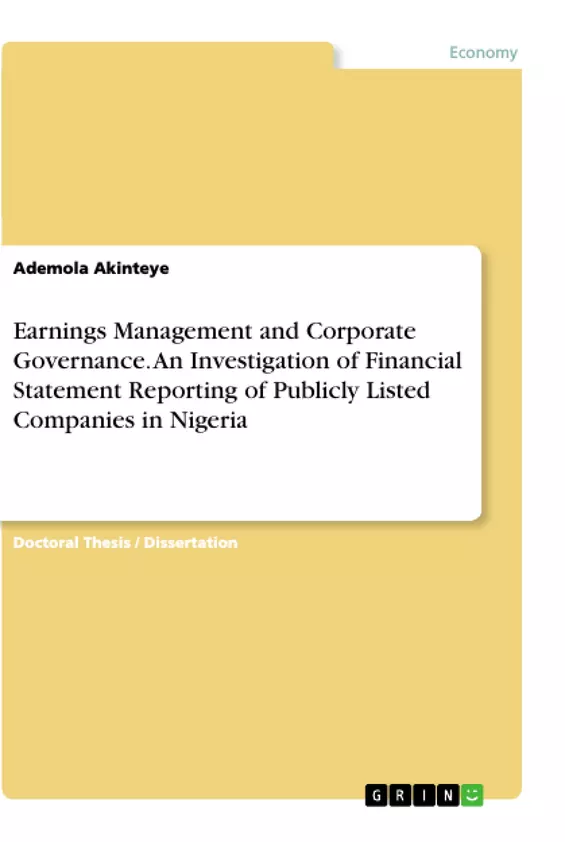The dissertation examined Earnings Management and Corporate Governance Governance Practices of the firms that are listed on the floor of the Nigerian Stock Exchange. The researcher investigated the published financial statements of all the listed companies across all the sectors of the exchange using empirical quantitative research methods. Al the variables of earnings management were extracted from the published annual financial statements and Directors Annual Reports through Content Analysis. The paper further explored all the variables of corporate governance as published by the Directors in the Annual Reports in the Financial Statements and through a face to face recorded interviews of the members of the Board of Directors, the members of the Audit Committees and the Heads of Internal Audit Functions in the Listed Public Companies.
The study documented that companies that are listed on the Nigerian Stock Exchange are involved in both the upward and downward earnings management practices. This findings cut across all the Sectors and categorization of the companies on the Nigerian Stock Exchange. The research thus recommended the need for better oversight by the Board of Directors, the Audit Committee and the Market Regulators mainly the Security and Exchange Commission and the Nigerian Stock Exchange.
The findings of the Research on Corporate Governance is mixed. In certain sectors, evidence of strong corporate governance are documented as reflected in the quality of Board Members, the Quality of the deliberations at the Board meetings, the independence of the Board, the independence of the Audit Committee and the independence and effectiveness of the Head of the Internal Audit function measured by the reporting line of the holder of this role. In some sectors, the ingredients of strong corporate governance were missing thus suggesting a need for a more stricter regime of corporate governance to be implemented in these corporations.
Inhaltsverzeichnis (Table of Contents)
- Chapter 1: Introduction
- 1.1 Background to the Study
- 1.2 Statement of the Problem
- 1.3 Objectives of the Study
- 1.4 Research Questions
- 1.5 Significance of the Study
- 1.6 Scope of the Study
- 1.7 Limitations of the Study
- 1.8 Organization of the Study
- Chapter 2: Literature Review
- 2.1 Conceptual Framework
- 2.2 Empirical Review
- Chapter 3: Research Methodology
- 3.1 Population of the Study
- 3.2 Sample and Sampling Technique
- 3.3 Data Collection Instrument
- 3.4 Data Collection Procedure
- 3.5 Data Analysis Technique
- Chapter 4: Results and Discussion
- 4.1 Descriptive Statistics
- 4.2 Correlation Analysis
- 4.3 Regression Analysis
- Chapter 5: Summary of Findings, Conclusion and Recommendations
Zielsetzung und Themenschwerpunkte (Objectives and Key Themes)
This thesis investigates the relationship between earnings management and corporate governance in publicly listed companies in Nigeria. The research aims to examine the extent to which earnings management practices are prevalent in these companies and to assess the role of corporate governance mechanisms in mitigating or exacerbating such practices. Furthermore, the study explores the potential impact of earnings management on the quality of financial reporting and investor confidence.
- Earnings management practices in publicly listed companies in Nigeria
- The role of corporate governance in mitigating earnings management
- The impact of earnings management on financial reporting quality
- The effect of earnings management on investor confidence
- The interplay between corporate governance, earnings management, and firm performance
Zusammenfassung der Kapitel (Chapter Summaries)
The first chapter introduces the research topic, providing a background on earnings management, corporate governance, and the Nigerian corporate landscape. It outlines the research problem, objectives, and research questions, as well as the significance and limitations of the study. The chapter also presents a detailed overview of the study's organization.
Chapter two delves into the theoretical underpinnings of earnings management and corporate governance, drawing upon relevant literature to establish a conceptual framework for the research. The chapter provides a comprehensive review of empirical studies exploring the relationship between these two concepts, highlighting key findings and theoretical perspectives.
Chapter three outlines the research methodology employed in the study, including the population, sample, sampling technique, data collection methods, and data analysis techniques used to address the research questions. The chapter provides a detailed explanation of the data sources and the procedures involved in collecting and analyzing data.
Chapter four presents the results of the empirical analysis, focusing on descriptive statistics, correlation analysis, and regression analysis. The chapter discusses the findings in relation to the research questions and the theoretical framework developed in previous chapters. The chapter also examines the implications of the results for understanding the relationship between earnings management and corporate governance in the context of the Nigerian corporate environment.
Schlüsselwörter (Keywords)
The primary focus of this thesis is on earnings management and corporate governance in publicly listed companies in Nigeria. Key terms and concepts explored include: earnings management, corporate governance, financial reporting quality, investor confidence, corporate social responsibility, firm performance, agency theory, stakeholder theory, and the Nigerian stock exchange. The study investigates the extent to which earnings management practices are prevalent in listed companies and the effectiveness of corporate governance mechanisms in mitigating or amplifying these practices.
- Quote paper
- Ademola Akinteye (Author), 2015, Earnings Management and Corporate Governance. An Investigation of Financial Statement Reporting of Publicly Listed Companies in Nigeria, Munich, GRIN Verlag, https://www.grin.com/document/505458



